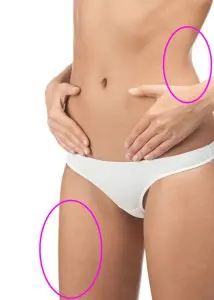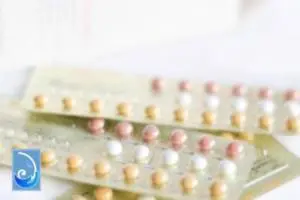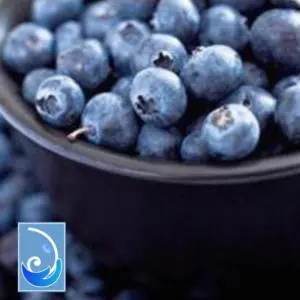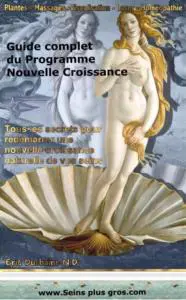
Due to health reasons, Mr. Duchaine is unable to offer this product online for the time being.
Please visit us again later.
What is estrogen?
 Estrogen is one of the two hormones used by the body to make breasts bigger, the second being progesterone. Unlike progesterone, if we include xenoestrogens (plastic, heavy metals, pesticides, etc.), estrogen and its effects are very easy to obtain. The difficulty lies more finding the best sources of estrogen for the body, in order to promote health. Vegetable sources, referred to as phytoestrogens, are in our opinion the best. This is why we include plants containing phytoestrogens in the program, and you will find more detail about this below.
Estrogen is one of the two hormones used by the body to make breasts bigger, the second being progesterone. Unlike progesterone, if we include xenoestrogens (plastic, heavy metals, pesticides, etc.), estrogen and its effects are very easy to obtain. The difficulty lies more finding the best sources of estrogen for the body, in order to promote health. Vegetable sources, referred to as phytoestrogens, are in our opinion the best. This is why we include plants containing phytoestrogens in the program, and you will find more detail about this below.
What does estrogen do?
Estrogen is the female hormone, which is responsible for developing feminine characteristics such as wide hips, curves and combined with progesterone: breasts. Estrogen is produced naturally by the ovaries during days 1 to 14 of the menstrual cycle, while progesterone is generated during the following 14 days.
The two hormones estrogen and progesterone balance each other out, and whilst an excess of progesterone is not dangerous, which is for example the case during pregnancy, excess estrogen is more problematic.

What does estrogen do for women?
In women, estrogen is mainly produced by the ovaries, but is also produced by fat cells and the adrenal glands. At the beginning of puberty, estrogen plays a role in the development of secondary sexual characteristics, such as breasts, pubic hair and hair in the axillary cavity (armpit). This sex hormone also helps to regulate the menstrual cycle, and controls the expansion of the lining of the uterus during the first stage of the cycle. At the end of the cycle, if the woman's egg is not fertilized, estrogen levels drop sharply and expulsion begins, referred to menstruation. If the egg is fertilized, estrogen combines with progesterone to prevent further ovulation during the upcoming pregnancy. This is the natural process that the contraceptive pill imitates. Estrogen also controls lactation and other changes in the breasts, including during adolescence and pregnancy.
For women, estrogen also plays a role in bone metabolism. Along with vitamin D, calcium and other hormones, estrogen helps maintain bone strength. Since estrogen levels begin to decline during menopause, estrogen deficiency results in bone loss around the age of fifty. This may be the reason why postmenopausal women are four times more likely to develop a bone disease, osteoporosis, than men of the same age group.
Estrogen also plays a role in blood clotting, maintaining the strength and thickness of the vaginal and uterus walls, along with vaginal lubrication (and a range of other body functions). Estrogen affects the skin, hair, mucous membranes and pelvis muscles.
These are the benefits of estrogen, but just like with everything else, there are also many negatives if too much is built up. As we said, estrogen can easily be found in our diet, and an excess of this hormone is called a state of estrogen dominance.
In the spirit of holistic health, it is important to also mention when talking about hormones such as estrogen, the foreign substances that influence us in the same way that estrogen does. They are known as xenoestrogens, and the term includes heavy metals, pesticides and plastics. These chemicals act on our bodies in a similar way to estrogen. In the environmental world that we live in, their presence must be taken into account, and this includes the process of detoxing our system in order to promote health.
In addition to weight gain, an estrogen imbalance or xenoestrogen intoxication may have many other symptoms, including:
• Allergies (asthma, hives, rashes or sinus congestion);
• Auto-immune conditions (lupus, etc.);
• Breast sensitivity, nodules or cysts;
• Cervical dysplasia;
• Cold hands and feet, slow metabolism (thyroid dysfunction);
• Decreased libido;
• Depression accompanied by anxiety or agitation;
• Dry eyes;
• Increased body fat, especially in the abdomen, hips and thighs;
• Gallbladder problems;
• Hair loss;
• Headaches, water retention, bloating;
• Inability to concentrate, memory loss;
• Increased blood clotting (increases the risk of cardiovascular issues);
• Irregular or excessive menstruation;
• Irritability, mood swings;
• Insomnia, excessive fatigue;
• Premenopausal bone mass loss;
• Premenstrual syndrome;
• Uterine fibroids; endometrial hyperplasia (cancer risk);
• And of course, increased risk of breast cancer.
Nature works with opposites. If we go too far in one direction, the situation may be regulated by going back in the opposite direction. Fortunately, all of the above symptoms can be avoided through rebalancing with bio-identical progesterone, and by following the tips we will give you below.
Estrogenic dominance
Given that estrogen and xeno-estrogens (plastics, heavy metals, pesticides) are found everywhere, the majority of women in today’s world are in a state of estrogen dominance. When the presence of estrogen is significantly higher than that of progesterone, it is known as an estrogenic dominance. As we can see, a dominance in estrogen leads to many unpleasant if not dangerous symptoms. This state of affairs is aggravated for women if we include these scenarios:
Excess production of estrogen:
Cysts and tumors on the ovaries can cause excessive estrogen production.
Stress also increases estrogen production.
Obesity is also responsible for increasing estrogen production through the fat cells and an enzyme that they generate. The more body fat you have, then the higher your estrogen levels, and the more estrogen you have, the more fat you build up on your hips, buttocks and breasts. This makes the vicious cycle of this hormone very clear, and equally the usefulness of bio-identical progesterone for weight loss. A little advice: if you want to lose weight, it is very important to stop using soy products and replace them with products that are rich in iodine (seafood, seaweed), because soy helps create hypothyroidism. Soy also impairs the absorption of zinc, copper and magnesium. It is a hazardous food product that should be removed from the market unless it is consumed in traditional form and comes from non-GMO sources. GMO sources contain a large number of pesticides, which are xenoestrogens.

Excess estrogen is usually eliminated by the liver. Liver diseases such as cirrhosis or a difficulty with enzyme production can prevent the liver from working. The liver uses vitamin B6 and magnesium to do its job and neutralize excess estrogen. Eating too much sugar forces magnesium to be eliminated and therefore disrupts the liver's ability to regulate estrogen levels. This is why magnesium is also another element to add if you want to quickly balance your hormone levels or lose weight.
Xenoestrogens:
Pesticides, heavy metals and plastics act as false estrogens in the body. Their effects are identical (weight gain, mood swings, confusion...). Thankfully, if the body is lucky, it will replace these substitute estrogens with natural estrogens, and it will do so by itself. This is the reason why people should never completely cut estrogen from their diet, but rather incorporate a certain amount of quality estrogens, like those included in the program. Eventually, the liver is able to eliminate the excess, once it has replaced the false estrogens - a replacement, a detoxification, that could not otherwise occur. Simply cutting off the sources of intoxication is not enough; the liver needs to be supported through quality natural replacement sources at the same time.
Estrogen supplements:

Foods should also be included in this category. Care must be taken not to consume too much. Our attention is drawn to soy in all its forms, traditional or not (tofu, soy milk, miso...) among others, but there is also:
• vegetables: soybeans, peas, haricot beans and lima beans
• fruits: cranberries, plums, apricots, etc.
• plants: oregano, cohosh, sage, liquorice
• whole grains
• linseed
• broccoli and cauliflower
Decreases in progesterone production:
We now know that progesterone counterbalances estrogen. Its absence thus enables states of estrogenic dominance. If a woman does not ovulate during her cycle, progesterone production may not occur. Age is a factor, too. If this happens frequently, this will deteriorate the balance between estrogen and progesterone. Low progesterone is also a frequent cause of miscarriage.
How do you control your estrogen levels?
One must differentiate between levels of real estrogen and xenoestrogen. These toxic elements come with another set of problems. Given that their accumulation did not happen overnight, we must expect their elimination to also be gradual. We therefore include it in our program without expecting rapid results so it will happen over time.

In addition to adding progesterone cream to your routine (see our article on progesterone) you must also think about the liver's ability to control these levels with magnesium and vitamin B6.
What are our daily magnesium intake requirements?
Children
Aged 1-3: 80 mg/day
Aged 4-8: 130 mg/day
Aged 9-13: 240 mg/day
Women
Aged 14-18: 360 mg/day
Aged 19-30: 310 mg/day
Aged 31 & above: 320 mg/day
Men
Aged 14-18 : 410 mg/day
Aged 19-30: 400 mg/day
Aged 31 & above: 420 mg/day
Magnesium rich foods
A few examples:
100g of seafood: 410 mg
100g of cocoa: 150 to 400 mg, based on the concentration
100g of almonds: 250 mg
100g of wholegrain bread: 80 mg
100g of brazil nuts: 370 mg
Other foods with a high magnesium content:
Whole grains, dried fruit, chocolate, cabbage, onion, alfalfa, seaweed, horsetail, wheat and barley sprouts, boiled spinach, etc...
To allow it to do its job, avoid overloading your liver with too much fat or alcohol.
Thyroid: Pay particular attention to iodine sources such as seaweed and seafood. Avoiding build ups of fat will regulate the thyroid, given that fat cells are generators of estrogen.
Also avoid plastic packaging (phthalates) and parabens. The latter are used in the cosmetic and food industry to prevent fungi growth, but they also have an estrogenic effect.
Eat these anti-estrogenic fruits and vegetables

When it comes to vegetables, we turn our attention towards the most well-known brassicas (cruciferous vegetables), and we find broccoli (probably the most consumed), kale, Brussels sprouts, cauliflower, etc.. These vegetables have one thing in common: they contain very favourable characteristics which help reduce estrogen levels.
In conclusion
By regulating your estrogen levels, even just a little bit, you bring health back to your breasts which allows them to grow, as long as you also take the right necessary steps. It is not necessary to be extremely strict with regards to this advice, but the presence of quality estrogens as opposed to xenoestrogens within the breast tissue ensures a faster response from the body, and therefore a more satisfactory natural growth.





